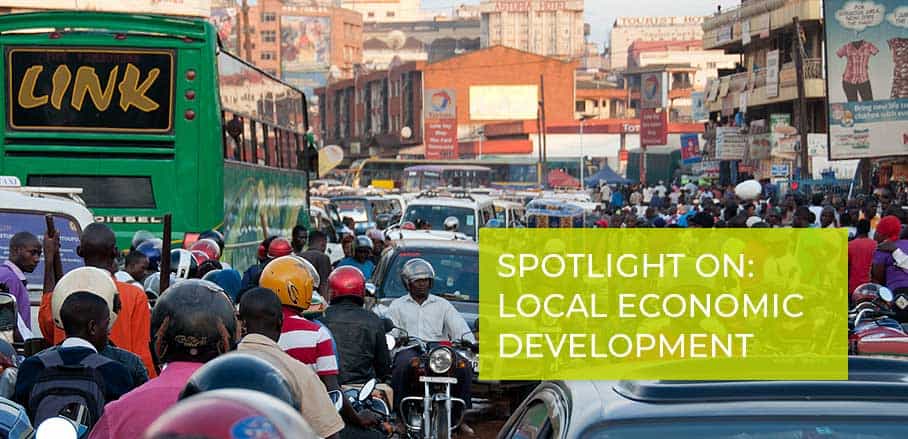Can Urban Planning Serve Local Economic Development?
In Kampala, Uganda, the immensely fast rate of urbanisation makes it hard for urban planners to keep up with developments. Madina Guloba argues that this makes it more important than ever for sustainable urban planning to keep local economic development (LED) approaches in mind.
Over the past decades, Uganda’s capital Kampala has increasingly become the country’s industrial hub. Its population has grown rapidly, as migrants from the countryside seek for opportunities that rural areas do not offer. The urban population (defined as residents of cities with a population of more than one million) has almost doubled from 1.74 million in 2007 to 2.84 million in 2017. The Greater Kampala Area has a population of about 3.5 million, increasing at a rate of about 5 per cent annually, mainly because of economic growth.
Such population growth comes with pressure on public services: among others, schools, hospitals, transport, water, electricity, sewage, and housing. Such services need to be designed and developed in anticipation of population size and of city dwellers’ economic situation. If urban planning fails to do so, congestion, pollution, slums, crime, low economic productivity are bound to arise.
This article analyses urban planning in Uganda with a focus on the city of Kampala. A core question in this regard is how an integrated plan can help Kampala to meet SDG 11: “make cities and human settlements inclusive, safe, resilient and sustainable”. Integrated planning enhances economic competitiveness of cities: not only through regulation of city infrastructure (roads and housing) and utilities (water and electricity), but also through enhancement of investments that improve economic growth and job creation.
Public Transport in Kampala: Long Overdue
Currently, the provision of an efficient inter and intra city public transportation system in the Kampala region is long overdue. Its lack is the cause of heavy traffic in Kampala, which leads to time wasted in traffic jams and which constrains the development of other growth sectors, such as tourism. The absence of physical plans has led to violation of basic physical infrastructure such as access roads, with some of them not even allowing for two cars to cross each other’s way because they are not wide enough.
To put this into context: for residents of the newly built urban residential areas such as Najeera and Nansana it is normal to leave for their workplace in the city centre as early as 5:30am. Otherwise, if on the public roads at 6am, to spend two hours stuck in traffic is quite common – for a distance of hardly 20 kilometres. This is due to a lack of connectivity, inefficient public transport, and poor maintenance of roads. Imagine the emission levels ensuing from such a practice!
In addition to functioning public transport, another approach to this problem would be to ensure that education and health service points are accessible from any resident’s home. This, however, is only possible where the quality of schools and hospitals is uniform across the city. If implemented, such a practice would immensely reduce traffic congestion and emissions caused by long distances to health and education services.
Infrastructure Development is Key to Local Economies
A key aspect of planning is the development of infrastructure. While the Ugandan government has achieved some objectives in the development of road and energy infrastructure – for example the Bujagali hydro-electric plant, the Entebbe Expressway, and the Jinja suspended bridge – it needs to put more effort into augmenting the benefits of such newly constructed infrastructure.
Benefits include increased domestic and foreign investments, reduced cost of doing business, increased revenue collections, reduced transportation costs due to less time spent on the road and reduced pollution from cars caught in traffic. Eventually, these aspects will lead to an increase in GDP growth for the local economy, as confidence of people in future infrastructure developments increases.
Kampala’s Housing Issue
Another aspect of infrastructure deficit is the housing deficit, evident in high prevalence of slums. Estimates suggest that Uganda needs 200,000 houses in urban areas alone every year. However, only 60,000 housing units are built annually. This deficit has given rise to the growth of informal housing units, which tend to be unsafe and lack basic sanitation.
The deficit not only causes growth of informal housing, which has negative impacts on the environment, as in the absence of physical plans the encroachment on natural ecosystem stabilisers such as swamps, rivers, and streams is common. It also negatively affects local economies as rents will be unnecessarily high and unregulated. Going forward, the Kampala Capital City Authority (KCCA) should enforce housing regulation to ensure that the economic impact of housing is more fully considered prior to building.
Making the Most of Urbanisation
The above aspects suggest that Kampala is in dire straits. The city needs to develop an integrated planning framework that brings together all the core facets making cities liveable and attractive – thus ensuring spill-over benefits for the local economy like increased incomes, employment, organised settlements, and integration to both domestic and external markets.
Making the most of the opportunities offered by urbanisation is important to successful green growth, and cities will play a distinctive role in Uganda’s development trajectory. If urbanisation is to unlock true long-term economic benefits as well as to help Uganda achieve middle income status by 2020 and to become an industrial hub by 2040, economic planning in Uganda must consider how development will play out spatially as part of a comprehensive green growth assessment.
- Can Urban Planning Serve Local Economic Development? - 15. January 2019
